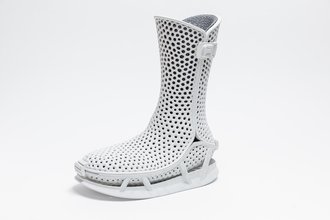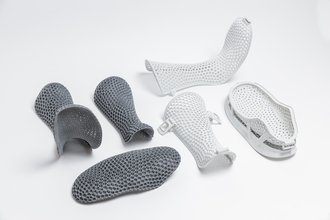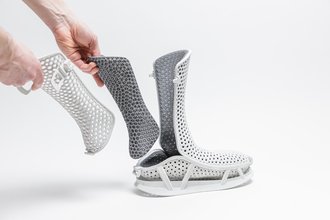Gold Medal for Customised Foot Orthosis Using 3D Printing
A project in the Faculty of Art and Design is working on digitally customised, 3D printed foot orthoses. The project will make everyday life easier for affected patients. Researchers on the »Digitale Orthetik« project were awarded a gold medal at the international »Ideen, Erfindungen, Neuheiten« (iENA) trade fair. The project was funded by the Thuringian Ministry for Economic Affairs, Science and Digital Society.
One in eleven adults suffers from diabetes and an estimated 425 million people worldwide have been diagnosed with the disease. Some of those affected develop what is known as Diabetic Foot Syndrome, which, if left untreated, may require the foot to be amputated or even lead to life-threatening complications. Consequently, many people need long-term treatment and are limited in their daily activities. But researchers at the Bauhaus-Universität Weimar are working on a solution.
The »Digitale Orthetik« research project is looking at the possibilities of combining digital design and 3D printing technology to created custom-made orthoses. The goal of the project is to put these innovative design and manufacturing processes into practice. The Faculty of Art and Design is working closely with »Sanitätshaus Rosenkranz Scherer GmbH« on this project. »Our focus is on patients with Diabetic Foot Syndrome and Charcot Foot, which is a specific severe form of the syndrome«, explains Niklas Hamann, who is working both on the project and pursuing his doctorate in this field.
»Conventional methods require that each orthosis be painstakingly handcrafted to fit the often severely deformed foot. This process takes several days. Our project relies on a completely digital process chain, which cuts the production time to less than half. We scan the affected foot and process the digital data in a virtual design environment. The result is custom-made orthotic components, which we then produce using 3D printing (Multi-Jet Fusion).«
Unique to the process is the orthosis’ three-part structure, which enables space-saving and efficient production in the 3D printer. This structure also makes it easier to put on and take off the orthosis, increasing patient comfort for patients and boosting the success of the therapy. The effectiveness of the orthosis has been successfully shown through several test runs and has been improved upon.
The orthosis is a modular construction: Soft pads made of TPU plastic (also 3D printed) are put into the outer shell. These can be replaced at any time. The ability to change the pads increases the product's lifespan and allows for sustainable, separate disposal. The orthosis also features a specially developed sole, which attaches at just eight points. This design provides a spring-like, flexible feeling when walking, which improves the user’s gait. Aesthetic factors were also taken into consideration to increase patient acceptance and reduce stigmatization.
You can watch a video of the entire process chain from scan to patient test here: vimeo.com/1027244706
The »Digitale Orthetik« project was presented at the »Patentmanagement Thüringer Hochschulen« stand at the »iENA« fair. The gold medal for the project will be formally presented at a ceremony at the Technischen Universität Ilmenau on Thursday, 12 December 2024.
»Digitale Orthetik« – a Cyber-Physical System for Customised 3D-Printed Foot Orthoses
Team:
Project Coordinator: Prof. Dr. Jan Willmann, Prof. Andreas Mühlenberend
Operational Project Coordinator: Niklas Hamann M.A.
Industry Partner: Rosenkranz Scherer GmbH
Funded by:
The State of Thuringia, Thüringer Ministeriums für Wirtschaft, Wissenschaft und Digitale Gesellschaft, »ProDigital« research programme.
For questions, please contact Niklas Hamann, artistic staff member in the Department of Industrial Design and Ph.D. candidate, by e-mail niklas.hamann[at]uni-weimar.de.
Kontakt
Bauhaus-Universität Weimar
Claudia Weinreich
Pressesprecherin
Tel.: +49(0)3643/58 11 73
Luise Ziegler
Mitarbeiterin Medienarbeit
Tel.: +49(0)3643/58 11 80
Fax: +49(0)3643/58 11 72
E-Mail: presse[at]uni-weimar.de
Web: www.uni-weimar.de/medienservice



